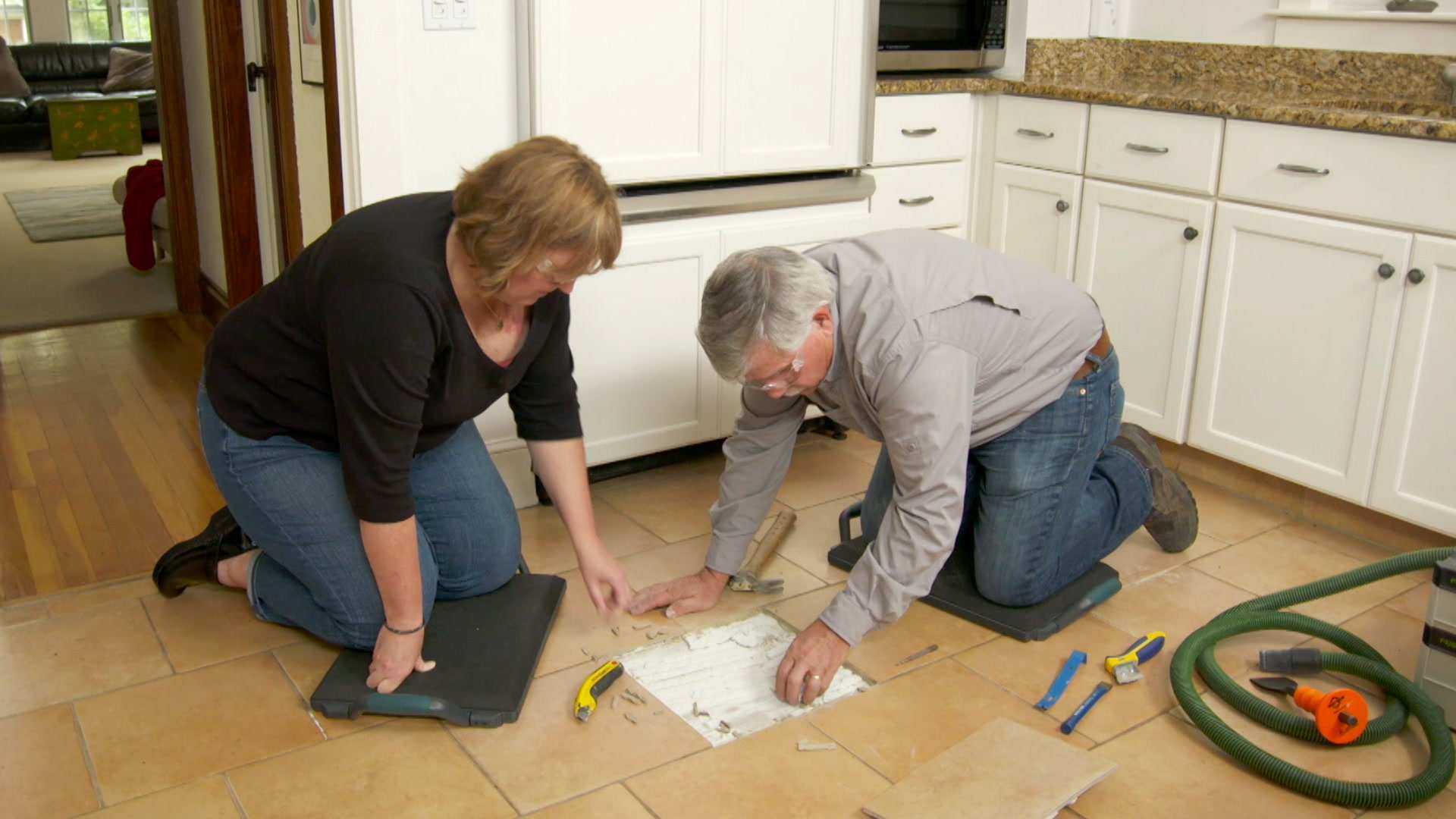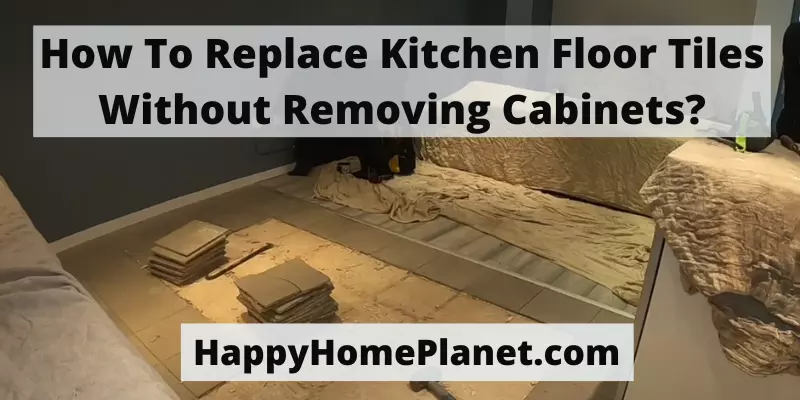Understanding the Challenge: Replacing Kitchen Floor Without Removing Cabinets

Replacing a kitchen floor without removing cabinets is a common dilemma for homeowners seeking a renovation without the hassle of a complete overhaul. This approach presents a unique set of challenges and advantages, influencing the decision-making process for those embarking on this project.
Advantages and Disadvantages
The decision to replace a kitchen floor without removing cabinets is often driven by practical considerations. This approach offers several advantages, including:
- Cost-effectiveness: Removing and reinstalling cabinets can significantly increase the project’s cost, making this approach a more budget-friendly option.
- Time efficiency: Avoiding the removal and reinstallation of cabinets can significantly reduce the project’s timeline, allowing for a faster turnaround.
- Minimal disruption: This method minimizes the disruption to the kitchen’s functionality, allowing for continued use during the renovation process.
However, it’s important to acknowledge the potential drawbacks associated with this approach:
- Limited flooring options: The presence of cabinets can restrict the choice of flooring materials, particularly those requiring underlayment or complex installation processes.
- Installation challenges: Working around cabinets can present challenges for achieving a seamless and aesthetically pleasing floor installation.
- Potential for damage: Care must be taken during the installation process to avoid damaging the cabinets or surrounding surfaces.
Kitchen Layouts
The suitability of replacing a kitchen floor without removing cabinets varies depending on the layout and design of the kitchen. Here are some examples:
- Open kitchen designs: Kitchens with an open floor plan and minimal cabinetry are generally more suitable for this approach, allowing for easier access and maneuverability during installation.
- Small kitchens: In small kitchens with limited space, removing and reinstalling cabinets can be a significant undertaking, making this approach a more practical option.
- Kitchens with base cabinets only: Replacing the floor without removing cabinets is generally easier if the kitchen only has base cabinets, as this allows for more space to work around the cabinets.
- Kitchens with extensive upper cabinets: Kitchens with extensive upper cabinets can pose challenges, as the limited access to the floor area can make installation difficult.
- Kitchens with island cabinets: The presence of island cabinets can further complicate the installation process, requiring careful planning and execution.
Planning and Preparation

A well-structured plan is the foundation of a successful kitchen floor replacement project, especially when aiming to avoid removing cabinets. This stage involves carefully considering the existing space, selecting the right materials, and taking necessary precautions to protect your valuable kitchen components.
Preparing the Kitchen
The first step in this endeavor is to thoroughly prepare your kitchen. This includes clearing the area, protecting surfaces, and ensuring the space is safe for the project.
- Clear the Space: Remove all items from the kitchen floor, including appliances, furniture, and any decorative elements. This will provide ample room for working and prevent damage to surrounding items.
- Protect Surfaces: Cover countertops, cabinets, and appliances with protective materials like drop cloths or plastic sheeting. This will safeguard them from dust, debris, and accidental spills during the renovation process.
- Safety First: Ensure the work area is well-lit and free of obstructions. Secure any loose items that could pose a tripping hazard. If necessary, use caution tape to mark off the work zone and prevent accidental entry.
Essential Tools and Materials
The tools and materials required for this project will depend on the type of flooring you choose. However, some essential items remain consistent regardless of the flooring type.
- Flooring: The choice of flooring is crucial. Consider options like luxury vinyl plank (LVP), engineered hardwood, or tile, which can be installed over existing subfloors. LVP is a popular choice for its durability, water resistance, and ease of installation.
- Underlayment: This layer is placed between the subfloor and the new flooring to provide insulation, sound dampening, and a smoother surface for installation. Options include foam underlayment, cork underlayment, and moisture barrier underlayment.
- Tools: You’ll need a variety of tools, including a measuring tape, utility knife, level, circular saw, jigsaw, hammer, flooring installation tools (like a tapping block and knee kicker), and a safety gear.
- Adhesive: Depending on the flooring type, you may need adhesive to secure the planks or tiles to the subfloor. Consult the manufacturer’s instructions for specific recommendations.
Protecting Cabinets and Appliances
Protecting your existing cabinets and appliances during the renovation is paramount. This requires meticulous planning and careful execution.
- Covering Cabinets: Cover cabinet doors and fronts with plastic sheeting or drop cloths to prevent damage from dust, debris, and paint splatters. Secure the coverings with tape to ensure they remain in place during the renovation.
- Appliance Protection: Disconnect appliances from power sources and cover them with protective materials. If possible, move appliances away from the work area to minimize the risk of damage. Consider using appliance covers or plastic sheeting for added protection.
- Careful Handling: During the renovation process, handle cabinets and appliances with utmost care. Avoid bumping or scraping them against the walls or other objects. If you need to move them, do so with caution and assistance.
Installation Techniques

Replacing your kitchen floor without removing cabinets requires careful planning and execution. You can choose from various methods, each with its own set of advantages and challenges. This section will guide you through the most common techniques, providing step-by-step instructions and tips for achieving a professional finish.
Tile Installation, Replacing kitchen floor without removing cabinets
Installing tiles around cabinets is a popular choice due to their durability and versatility. Here’s a step-by-step guide:
Prepare the Subfloor
Ensure the subfloor is level and smooth, as any unevenness will show through the tiles. This involves patching any cracks or holes and sanding down any bumps.
Install a Moisture Barrier
To protect your subfloor from moisture, install a moisture barrier, such as a polyethylene sheet, over the subfloor.
Lay the Tile
Start laying the tiles from the center of the room, working outwards towards the cabinets. Cut the tiles around the cabinets to fit snugly, using a wet saw for precise cuts.
Apply Mortar
Apply a thin layer of mortar to the subfloor before laying the tiles. Use spacers to ensure even spacing between the tiles.
Grout the Tiles
Once the mortar has dried, grout the tiles, filling the gaps between them. Use a grout float to smooth the grout and remove excess.
Seal the Grout
Apply a sealant to the grout to protect it from stains and moisture.
Tips for Professional Finish
– Use a level to ensure the tiles are installed level.
– Cut the tiles with a wet saw for clean, precise cuts.
– Use spacers to ensure even spacing between the tiles.
– Allow the mortar to dry completely before grouting.
– Use a grout float to smooth the grout and remove excess.
– Apply a sealant to the grout to protect it from stains and moisture.
Replacing kitchen floor without removing cabinets – Replacing your kitchen floor without removing cabinets can be a surprisingly achievable project. If you’re looking to save money on the cabinets themselves, consider browsing craigslist kitchen cabinets free listings. You might find a treasure trove of usable cabinets that perfectly complement your new flooring, giving your kitchen a fresh, updated look without breaking the bank.
Replacing your kitchen floor without removing the cabinets can be a great way to refresh the space without a major overhaul. However, if you’re considering a full kitchen renovation, you might want to explore the option of removing the cabinets entirely, which can be done safely and efficiently by following these steps: how to remove kitchen cabinets.
Once the cabinets are out, you’ll have a blank slate for a complete kitchen makeover, allowing for a new floor to be installed seamlessly.
